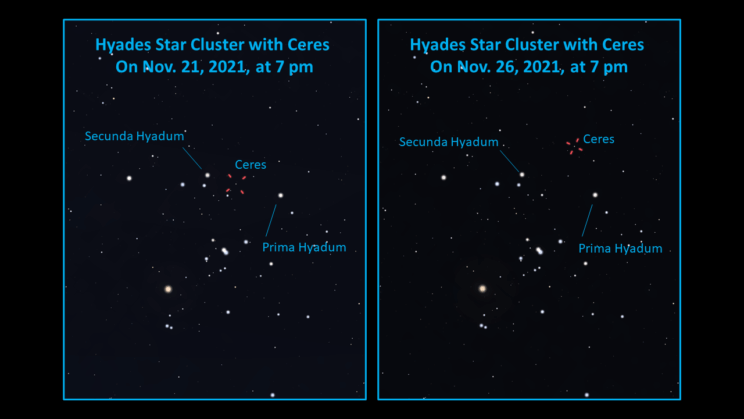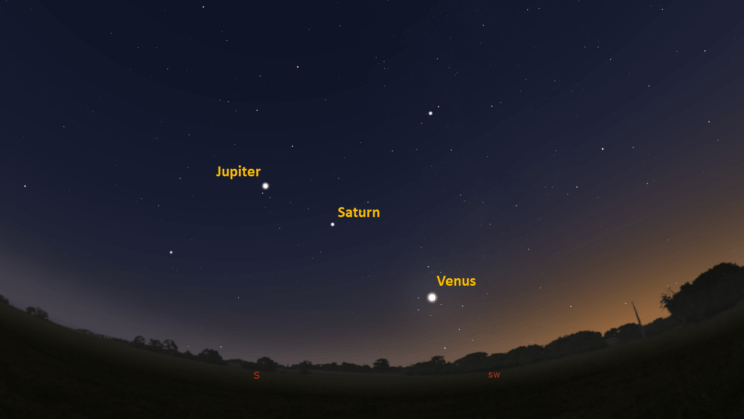This is the Saint Louis Science Center’s NIGHT SKY UPDATE for the week of Friday, November 19, 2021.
Information updated weekly or as needed.
Times given as local St. Louis time which is Central Standard Time (CST). For definitions of terminology used in the night sky update, click the highlighted text. If relying on times posted in Universal Time (UT), St. louis is -6 hours when CST.
Public Telescope Viewings
With the changing recommendations from the CDC regarding COVID-19, conversations regarding the return of star parties at the Saint Louis Science Center have begun. We are close to bringing back our public telescope viewings, but a few details still need to be worked out. We will post future updates as we learn more about when we can bring back telescope viewings.
Observing Highlight of the Week

Location of Ceres on November 21 and 26, 2021. Ceres is currently bright enough to see through binoculars. As the week goes on the Moon will move away from taurus making Ceres easier to spot. Image created using Stellarium.
Hopefully everyone got a chance to see the partial lunar eclipse that occurred on November 19, 2021, from midnight to 6:00 a.m. For many observers, this eclipse offered an opportunity to observe other objects that normally would be difficult due to the bright full moon. As we have covered in past iterations of the night sky update, the Moon looks brighter during and near its full phase due to the opposition effect. However, when the Moon passes into Earth’s umbral shadow, observing conditions improve enough that some deep sky objects were a nice addition to the nights observing list. M41, M42 and M44 were a few targets to track down as the eclipse progressed.
Around the time of greatest eclipse, I took the opportunity to locate the dwarf planet Ceres which reaches opposition on November 26, 2021, at 10:00 p.m. CST. Like the Moon, Ceres appears brightest each year as it reaches opposition. When it reaches opposition on November 26, 2021, Ceres is expected to appear as a 6.98 magnitude object. This means you will only need binoculars to track down this dwarf planet.
Ceres was discovered in 1801 by Giuseppe Piazzi. Astronomers at the time were hoping to find the next planet as it was believed there was a yet to be discovered planet somewhere between Mars and Jupiter. Instead of finding a planet, astronomers eventually discovered numerous rocky bodies that together make up the Main Asteroid Belt. This structure is comprised of leftover bits from the formation of our solar system. Ceres is the largest object in this region with an equatorial radius of 476.2 km. That makes Ceres about 13 times smaller than the Earth or 3.6 times smaller than the Moon.
To find Ceres this week you need to locate a star cluster called the Hyades in the constellation Taurus. The Hyades is an easy object to spot naked eye. It is known under the designations of Melotte 25, Collinder 50 or Caldwell 41 and it appears as a V-shape of stars in the nose of Taurus. The bright star Aldebaran looks like it is part of the Hyades, but it is much closer to us that the star cluster. Once you can find the Hyades, you want to identify the stars Secunda Hyadum and Prima Hyadum. On November 21, 2021, Ceres can be found about halfway between these stars. On November 26, 2021, Ceres will be fond roughly 1° west of where it was on the 21st.
Ceres is a fascinating object in our solar system. It is worth grabbing binoculars to track down this dwarf planet this week is skies are clear. If Ceres piques your curiosity, I recommend reading about the NASA mission called Dawn. This spacecraft first visited the asteroid 4 Vesta, but it orbited Ceres from 2015 to 2018. One point of interest is the large crater on Ceres called Occator. Dawn found bright spots in the cater that are thought to be caused by a salty brine from deep deposits erupting to the surface of Ceres. You can learn more at https://www.nasa.gov/feature/jpl/bright-spots-and-color-differences-revealed-on-ceres.
The Sun and Moon

The Moon as seen from the International Space Station, on July 31, 2011.
Credit: NASA
Sunrise is at 6:47 a.m. on Friday, November 19 and sunset is at 4:45 p.m. providing us with roughly 10 hours of daylight. Even after sunset, the light from the Sun will dimly illuminate our sky for roughly 1 hour and 30 minutes. This period is called twilight, which ends around 6:17 p.m. this week. For those with a sundial, local noon occurs around 11:46 a.m. this week.
| Day | Sunrise | Sunset |
|---|---|---|
| 2021-11-19 | 6:47 a.m. | 4:45 p.m. |
| 2021-11-20 | 6:49 a.m. | 4:44 p.m. |
| 2021-11-21 | 6:50 a.m. | 4:43 p.m. |
| 2021-11-22 | 6:51 a.m. | 4:43 p.m. |
| 2021-11-23 | 6:52 a.m. | 4:42 p.m. |
| 2021-11-24 | 6:53 a.m. | 4:42 p.m. |
| 2021-11-25 | 6:54 a.m. | 4:42 p.m. |
| 2021-11-26 | 6:55 a.m. | 4:41 p.m. |
| 2021-11-27 | 6:56 a.m. | 4:41 p.m. |
Moon
Moonrise for Friday, November 19 occurs at 5:01 p.m. and moonset will occur on the following day ay at 8:00 p.m. On Friday, November 19 the Moon will exhibit a full phase. Full moon occurs on November 19 at 2:58 a.m. Full moon occurred at 2:58 a.m. on November 19, 2021. Last quarter moon occurs on November 27, 2021, at 6:28 a.m.
International Space Station (ISS) Observing

Visible passes of ISS from St. Louis for the week of November 19 occur during evening hours. The best pass this week occurs on the evening of November 21. Use the table below for information about this and other visible passes this week.
Catch ISS from St. Louis starting Friday, November 19
| Date | Starts | Max. altitude | Ends | |||||||
|---|---|---|---|---|---|---|---|---|---|---|
| Time | Alt. | Az. | Time | Alt. | Az. | Time | Alt. | Az. | ||
| 20 Nov | -2.5 | 18:28:17 | 10 | W | 18:31:25 | 34 | NNW | 18:31:49 | 33 | NNW |
| 21 Nov | -3.2 | 17:40:56 | 10 | WSW | 17:44:16 | 54 | NW | 17:46:47 | 16 | NE |
| 22 Nov | -1.5 | 18:32:04 | 10 | WNW | 18:34:25 | 17 | NNW | 18:34:41 | 17 | NNW |
| 23 Nov | -1.8 | 17:44:22 | 10 | W | 17:47:09 | 23 | NNW | 17:49:32 | 12 | NNE |
| 25 Nov | -1.2 | 17:48:29 | 10 | NW | 17:50:14 | 13 | NNW | 17:51:59 | 10 | NNE |
Magnitude (Mag): The Measure of brightness for a celestial object. The lower the value is, the brighter the object will be.
Altitude (Alt): The angle of a celestial object measured upwards from the observer’s horizon.
Azimuth (Az): The direction of a celestial object, measured clockwise from an observer’s location with north being 0°, east being 90°, south being 180° and west being 270°.
For information about ISS flyovers and other visible satellites, visit www.heavens-above.com
Detailed information regarding all unmanned exploration of our universe, missions past, present, and planned, can be found at Jet Propulsion Laboratories:
The Visible Planets

Looking South, at 5:30 p.m. November 19, 2021. Credit: Stellarium, EG

Looking east, at 6:29 am, November 20, 2021. Credit: Stellarium, EG
This week, three naked eye planets are visible. Venus can be found in the south southwest after sunset. Jupiter and Saturn can be found in the south after sunset. Mars is still tough to see but you can now find it in the east about 20 minutes before sunrise.
Venus
Venus is well into another evening apparition. By 6:15 p.m., Venus will be about 16° above the south southwestern horizon. Venus will set at 7:26 p.m. Venus reached maximum eastern elongation October 29, 2021. Venus is now headed back towards the Sun as it approaches inferior conjunction on January 8, 2022.
Mars
A new apparition for Mars has begun. For most of us, Mars will remain elusive unless your southeastern view is clear at the horizon. Currently Mars rises at 5:41 a.m. 20 minutes before sunrise, Mars will only be roughly 6° above the horizon. Mars will continue to climb out of the Sun’s glare as we see the end of 2021. Mars will reach opposition next year on December 7, 2022.
Jupiter
Jupiter has passed opposition and as such will be visible about 30 minutes after sunset. Look for Jupiter in the south as it starts to darken outside. Jupiter sets at 11:01 p.m. and will set about 30 minutes earlier each week. Jupiter reaches superior conjunction on March 5, 2022. This means we can count on seeing Jupiter in the southern skies for the rest of this year and well into 2022.
Saturn
Saturn is past opposition which means it will be visible about 30 minutes after sunset. Right now, it can be found in the south after sunset, but as we continue through the year, Saturn will set about 30 minutes earlier each night. Saturn sets at 9:41 p.m. Saturn will reach superior conjunction on February 4, 2022.
James S. McDonnell Planetarium
Night Sky Update: November 19 – November 27, 2021






